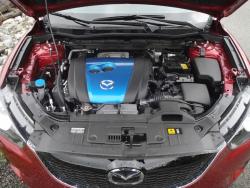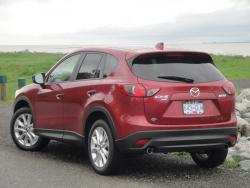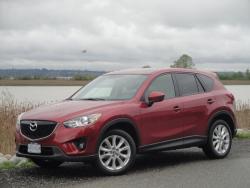2013 Mazda CX-5 GT AWD. Click image to enlarge |
|
First Drive: 2013 Mazda CX-5
Manufacturer’s web site |
Review and photos by Greg Wilson
Photo Gallery:
2013 Mazda CX-5
Imagine this scenario: Mazda executives sit down with their North American advertising agency to explain how the new CX-5 crossover breaks new ground in fuel-efficient engine and transmission technology, lightweight body design, nimble handling, and spacious cabin layout. The ad execs exchange a few words, and a young account rep stands up and says, “Let’s do a TV commercial with the CX-5 speeding across a dry lake bed at 100 miles an hour! And we’ll throw in a few 360s! Zoom, zoom, baby—yeah!”
You’ve probably seen that commercial. Please ignore it. The CX-5 is not about high-speed, record-breaking performance. This compact crossover is all about engineering efficiency and driving enjoyment—the first product of Mazda’s new “SkyActiv” product design approach. A few years ago, Mazda embarked on a top-down re-evaluation of its powertrains, suspensions, body structures and vehicle components with the goal of reducing weight, improving fuel efficiency, and making their vehicles (even) more driver-friendly. The first fully SkyActiv vehicle, the CX-5, boasts the best (officially rated) fuel economy in its class, 7.8/5.7 city/hwy (FWD, 6-speed manual) and 8.0/6.4 city/hwy (AWD, 6-speed auto) (Natural Resources Canada figures), and is arguably the most fun-to-drive small crossover on the market.
   2013 Mazda CX-5 GT AWD. Click image to enlarge |
The CX-5’s new 2.0L DOHC four-cylinder gas engine with direct fuel injection and an unheard of 13:1 compression ratio, puts out 155 horsepower at a peaky 6,000 rpm and 150 lb-ft of torque at 4,000 rpm. Even though that’s between 10 and 30 horsepower less, and 10 and 30 lb-ft less than its major competitors’ four-cylinder engines, the CX-5 still offers comparable acceleration times. When equipped with the six-speed automatic transmission and all-wheel drive, Consumer Reports records the CX-5’s 0–60 mph (0–96 km/h) at a time of 10 seconds. That compares to the 185-hp Honda CR-V with 9.2 seconds, the 179-hp (4-cyl) Toyota RAV4 with 10 seconds, the 165-hp Hyundai Tucson at 9.7 seconds, and the 170-hp Subaru Forester at 10.2 seconds. During a week of mostly urban driving with a few freeway trips thrown in, I found the engine’s torque, when combined with the automatic transmission’s well-spaced gear ratios, well suited to quick take-offs from traffic lights and snappy lane-changes around town. The weakness with the CX-5’s engine is that it can get busy and noisy when accelerating hard, and it labours when passing other cars on the highway. But in typical city and highway driving, you’ll find the CX-5’s powertrain sufficiently smooth and capable. Cruising on the freeway at a steady 100 km/h, my tachometer was reading just 2,200 rpm in top gear, one reason why it offers such good highway fuel economy.
The best thing about the CX-5’s performance, as other reviewers have noted, is its quick and responsive steering, and nimble handling. It offers a fully independent suspension and standard 17-inch tires (beefy 19-inch tires on the GT). Unlike many small SUVs, the CX-5 feels “light on its feet”. You don’t get the feeling you’re carrying around extra weight. In fact, with a base curb weight of 1,459 kg (1,555 kg AWD, 6-speed auto), the CX-5 is one of the lightest compact crossovers in its class, which explains why it can still offer competitive acceleration times with a less powerful engine.
It’s important to note that the CX-5 is not lighter because it’s smaller — the CX-5 has the longest wheelbase in its class (2,700 mm/106 in.) and is actually a bit longer and taller than the Honda CR-V. It’s lighter because Mazda engineers went to great lengths to take weight out of the engine, transmission, suspension, and body as part of their SkyActiv philosophy.











